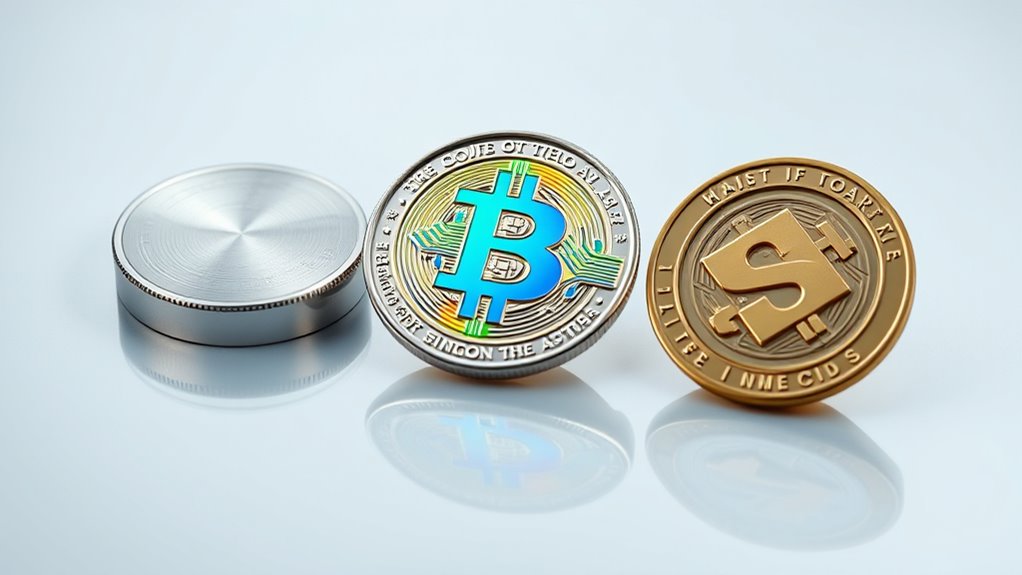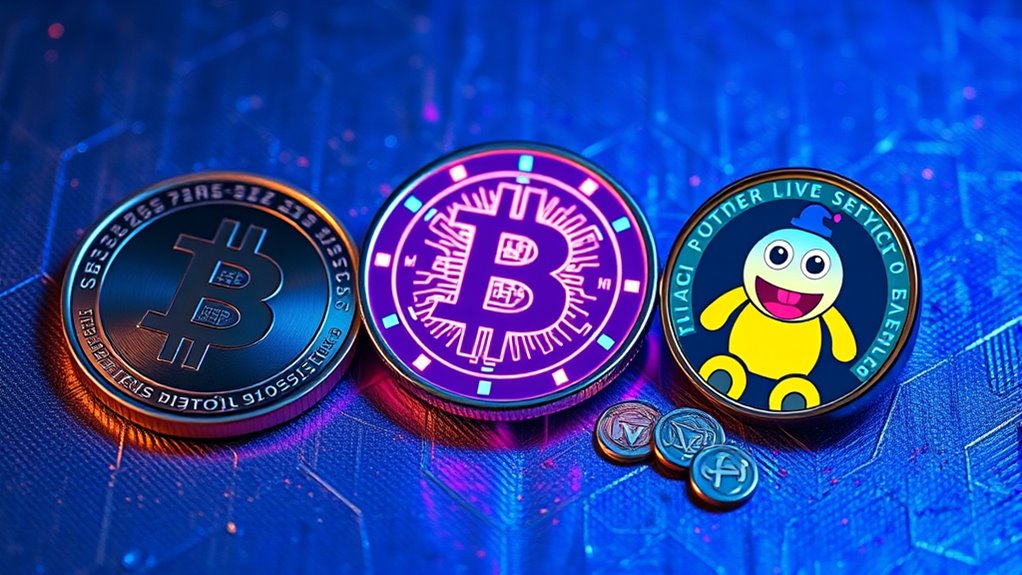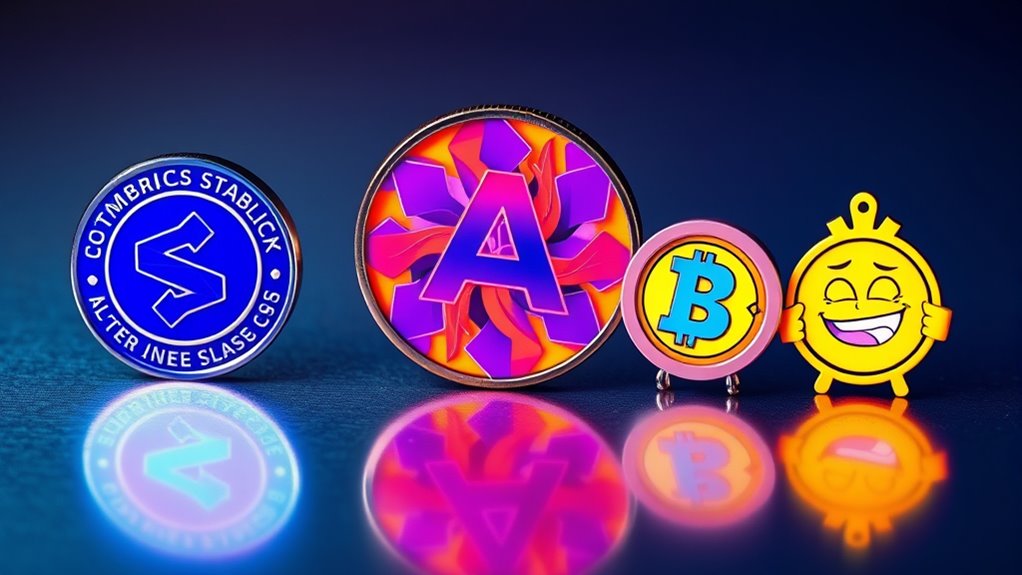Stablecoins aim to maintain a steady value by backing their tokens with fiat reserves or using algorithms, making them ideal for trading and hedging. Altcoins, on the other hand, focus on technological innovations and have more volatile prices driven by speculation. Memecoins are highly speculative and often fueled by social media hype. Understanding these differences helps you make informed decisions; exploring further reveals how each type impacts your crypto experience.
Key Takeaways
- Stablecoins are pegged to fiat currencies and prioritize stability, while altcoins and memecoins are more volatile and driven by speculation.
- Stablecoins use reserves or algorithms to maintain their value; altcoins and memecoins lack such backing and depend on market sentiment.
- Altcoins offer diverse functionalities like smart contracts and privacy features; memecoins are mainly created for entertainment or hype.
- Stablecoins are primarily used for trading, hedging, and remittances; memecoins are often speculative assets driven by social media hype.
- Risks vary: stablecoins face regulatory and de-pegging issues; altcoins and memecoins are susceptible to market manipulation and technological vulnerabilities.
What Are Stablecoins, Altcoins, and Memecoins?

To understand the differences among stablecoins, altcoins, and memecoins, it’s helpful to start with their basic definitions. Stablecoins are cryptocurrencies designed to maintain a steady value, usually pegged to a fiat currency like the US dollar. They provide stability in volatile markets and are often used for transactions and savings. Altcoins refer to any cryptocurrency other than Bitcoin; they encompass a wide range of projects aiming to improve or differ from Bitcoin’s features. Memecoins are a subset of altcoins that gain popularity through internet culture and social media hype, often driven by humor or memes rather than technical innovation. While stablecoins focus on stability, altcoins and memecoins tend to emphasize technological innovation, community, or entertainment. Additionally, understanding well-being tips can help investors maintain mental health when navigating the volatile cryptocurrency landscape, especially given the market fluctuations that are common in this space. Recognizing the different risk profiles associated with each type of cryptocurrency can also aid in making informed investment decisions.
How Do They Maintain Value and Stability?

Stablecoins maintain their value by being backed by reserves, such as fiat currency or other assets, which are regularly audited to guarantee transparency. This backing guarantees that each stablecoin can be exchanged for a specific amount of the reserve asset, helping maintain price stability. Some stablecoins, like USDC or USDT, hold reserves in fiat currency held in banks, providing confidence in their stability. Others, like algorithmic stablecoins, rely on complex algorithms and smart contracts to control supply based on demand, aiming to keep their value steady without physical backing. In contrast, altcoins and memecoins are often driven more by market speculation and hype, making their value less predictable and more volatile. Their stability depends heavily on market sentiment rather than intrinsic backing. Additionally, AI Security advancements are crucial for safeguarding the integrity of digital assets and maintaining trust in these financial instruments, especially as blockchain technology continues to evolve. The market dynamics of these cryptocurrencies are constantly changing, requiring ongoing attention to security and regulatory developments. As the decentralized nature of these currencies influences their stability, ongoing innovations in security protocols are essential to prevent manipulation and fraud.
What Are the Risks and Use Cases for Each Type?

Each type of cryptocurrency carries its own set of risks and potential uses, shaping how you approach them. Stablecoins offer stability and are useful for trading, remittances, and protecting against volatility, but they face risks like regulatory crackdowns or de-pegging issues. Understanding credit card terms is essential for navigating financial literacy, which also applies to managing digital assets securely. Additionally, the backing mechanism of stablecoins can impact their reliability, making it important to understand the pegging process. The financial regulation environment can significantly influence stablecoin stability and acceptance, adding another layer of risk to consider. Moreover, as cyber threats evolve, the security of digital assets depends on robust AI security measures to prevent theft and fraud. Altcoins provide diverse functionalities, from privacy to smart contracts, but they can be highly volatile and susceptible to security flaws or market manipulation. Memecoins, driven by hype and community support, can deliver quick gains but are often speculative and lack intrinsic value, making them risky investments. Understanding these risks helps you choose appropriate assets for your goals. Use cases vary: stablecoins for stability, altcoins for innovation, and memecoins for speculative trading or entertainment. Incorporating natural and organic juices into your health routine can also support your overall well-being, especially when choosing fresh organic produce. Always research thoroughly before investing.
Frequently Asked Questions
How Do Regulatory Frameworks Differ for Stablecoins, Altcoins, and Memecoins?
You’ll find that regulatory frameworks differ markedly for stablecoins, altcoins, and memecoins. Stablecoins often face stricter rules because they’re pegged to real assets, making regulators wary of financial stability risks. Altcoins usually encounter lighter regulation but must follow securities laws if classified as investment products. Memecoins, being more speculative and less established, often avoid regulation altogether, but this can change as authorities increase oversight.
Can Memecoins Ever Become Stable or Widely Adopted?
You wonder if memecoins can ever become stable or widely adopted. While memecoins are driven by community hype and memes, they face challenges in stability and mainstream acceptance. However, if developers introduce real utility, improved security, and broader acceptance, some memecoins might gain stability and adoption. Still, it’s uncertain whether they’ll ever match the stability and trust of established cryptocurrencies, but innovation could change that.
What Technological Differences Exist Among Stablecoins, Altcoins, and Memecoins?
You wonder what sets these coins apart technologically. Stablecoins rely on blockchain technology with backing assets or algorithms to maintain stability. Altcoins often improve upon Bitcoin’s code, introducing new features or consensus methods. Memecoins typically copy existing models with minimal innovation, often lacking the robust infrastructure of stablecoins or altcoins. This technological gap influences their stability, utility, and potential for widespread adoption, making the differences essential to understanding their roles in crypto.
Are There Specific Investment Strategies for Each Type of Cryptocurrency?
You should tailor your investment strategies based on each crypto type’s characteristics. For stablecoins, focus on preserving capital and earning interest through staking. For altcoins, consider long-term holding if they have solid fundamentals, or short-term trading to capitalize on volatility. Memecoins are high-risk and speculative; if you invest, do so with only what you can afford to lose and set strict exit points. Adjust your approach accordingly.
How Do Market Sentiments Influence Memecoin Prices Compared to Stablecoins?
Market sentiment heavily influences memecoin prices because they’re driven by hype, social media trends, and community excitement. When positive buzz spreads, prices can soar quickly, but they can also crash just as fast if enthusiasm fades. Stablecoins, on the other hand, stay relatively unaffected by sentiment since they’re pegged to stable assets like the dollar. Your investments in memecoins are more volatile and sentiment-driven, while stablecoins offer stability.
Conclusion
Understanding the differences between stablecoins, altcoins, and memecoins helps you make smarter crypto choices. While stablecoins offer stability, altcoins and memecoins can be more volatile but also present unique opportunities. Don’t dismiss memecoins as mere jokes—they can sometimes deliver surprising gains. So, whether you’re seeking security or potential growth, knowing these types lets you navigate the crypto world confidently. After all, with the right knowledge, you can avoid pitfalls and seize the best opportunities.










